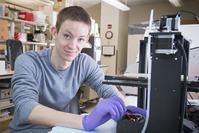Senior Design Projects Course Hooks Students on Translational Research and Design
Weldon School seniors experience the design process from need identification and idea generation through the iterative process to ultimately resolution of a real problem in healthcare delivery.
In an ideal scenario, the senior design experience for undergraduates would be one which closely resembles the real world, a world in which people of diverse backgrounds and expertise join forces to design solutions that address challenging real-world biomedical problems at the interface of engineering and living systems.
In the real world, such an experience fosters pioneering discoveries that are as rewarding to the engineer as they are to the patients who ultimately benefit from the discoveries after they move into the clinical setting.
Now, at the Weldon School, seniors can have that experience. Sherry Voytik-Harbin, an associate professor of biomedical engineering, and one of the co-PIs on the five-year project, spoke about how the course sets up undergraduate students to fully appreciate the biodesign process and to reap the rewards.
“We wanted to get students out into the clinical environment to identify unmet clinical needs,” said Voytik-Harbin. “We wanted them to think about the big picture, such as FDA issues and who is going to pay. The students also should have enough exposure to technology transfer, intellectual property, and commercialization to be able to successfully take their design from the classroom to the clinical market. We wanted them to experience working in multidisciplinary teams that include industry partners, clinicians, faculty, and their teammates, which may include an ECE or an ME.”
“And if in the process we get students hooked on translational research, all the better,” Voytik-Harbin added. “Sometimes the experience can be life-changing.” Sometimes students find themselves in senior design, and that changes the trajectory of their career.
That was the case with Will Hoggatt, a Weldon senior. Hoggatt was part of a team mentored by Voytik-Harbin that developed a 3D bioprinter to more accurately model the metabolic and physiological function of a human tissue to allow for more cost effective drug screening. (To see a video developed by the team that summarizes the project select the "Enhancing preclinical drug screening using 3d bioprinted tissue constructs" video on the Purdue BME YouTube channel.)
“I definitely got hooked on translational research,” said Hoggatt. “Getting hooked was just a matter of luck in the sense that I happened to really enjoy the project I was assigned to, and the group I was with…Almost every day I ended up spending hours and hours coding and working on ideas, but it didn't feel like school work. I couldn't wait to try out a new snippet of code, or try a new design.”
The effort paid off, and Hoggatt recalled the joy he felt when he finally achieved the objective of making the printer move with the code he had written. “I had been getting stuck in the first two to three lines of code which connected me to the printer. It took at least a week to get the code working, which was extremely frustrating because those lines were the very first step in getting this thing to work. I wrote code to move the printer while waiting for help to connect, so the first time it moved with my code I was unproportionally happy. That's when I got really excited to take this research as far as I could.”
It was about this time that Hoggatt’s life began to change course. During the senior design semester, Hoggatt was interviewing for a job in industry. But, Voytik-Harbin saw his passion and talent for translational research and design and encouraged him to stay at Purdue and pursue a graduate degree. It didn’t take long for Hoggatt to change his plans. The success he had in senior design coupled with the positive encouragement from faculty mentors clinched his decision to enter the Weldon graduate program after graduation.
“I looked at it as an opportunity to apply what I learned and actually make something that could one day be useful,” Hoggatt said as he reflected on the experience. “That was why I wanted to become an engineer in the first place.” Hoggatt plans to continue working on the 3D bioprinter project in grad school and perhaps one day start a business with the finished product.


